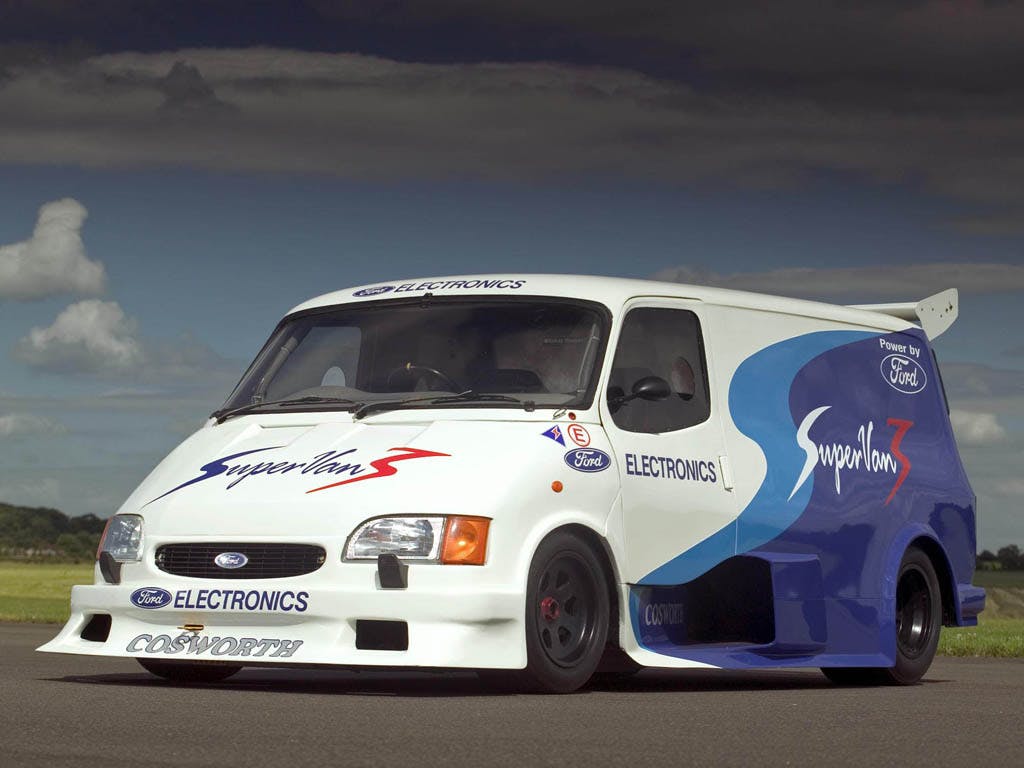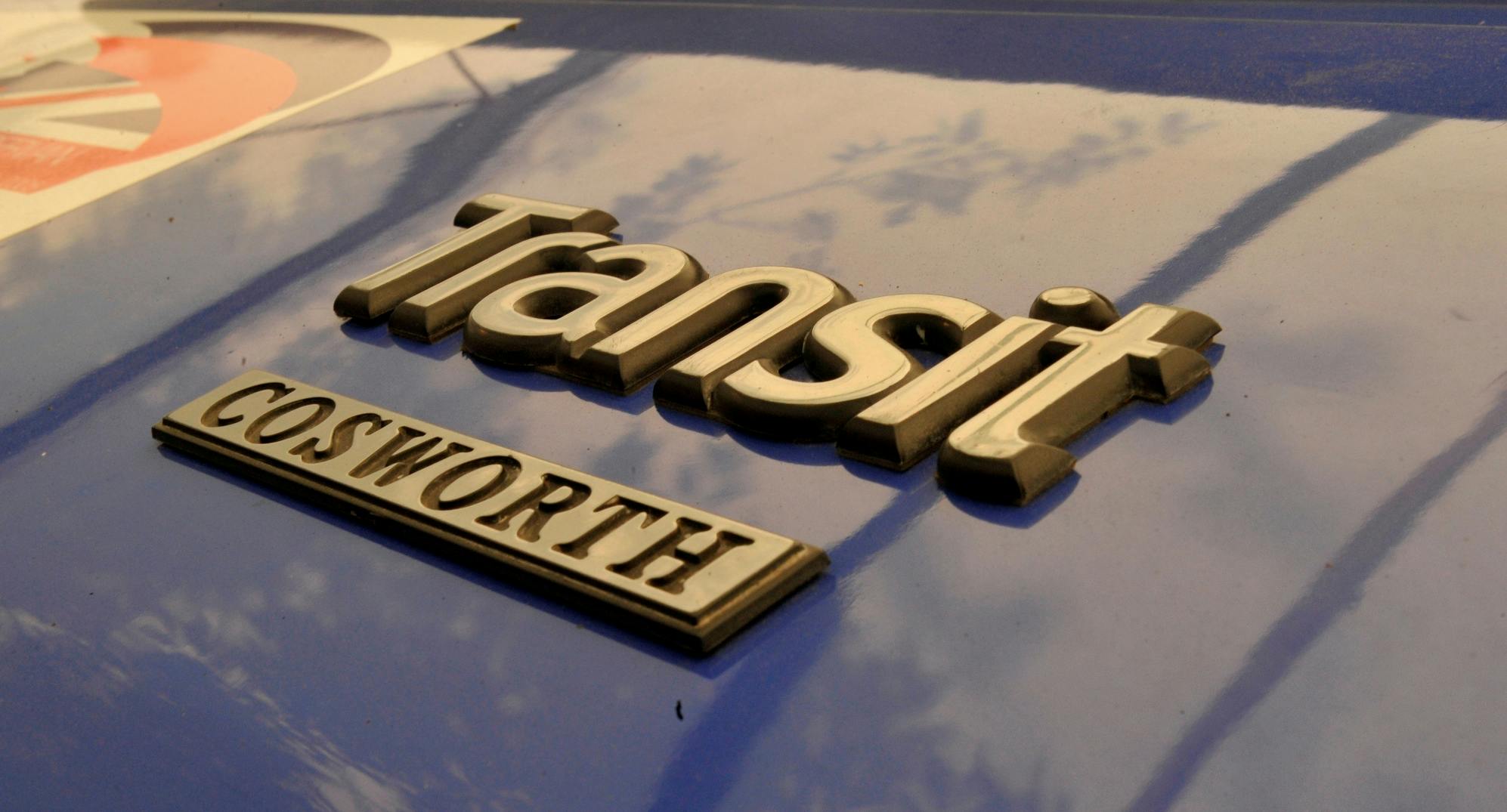These 4 Transit SuperVans predate Ford’s electric hill-climber
Seeing a Ford Transit at the Goodwood Festival of Speed is, on its own, nothing remarkable. How else would all the chairs and tents and displays get there, to say nothing of the mechanics’ tools and race marshals’ safety equipment? This year, however, spectators at Goodwood were treated to the sight of a Transit in a different kind of action, blitzing up the hill on a surge of all-electric power.
Boasting four electric motors for a total of 1973 hp, the Ford Electric SuperVan is capable of getting to 60 mph in under two seconds. With Le Mans winner Romain Dumas at the wheel, it made short work of Goodwood’s hillclimb. Naturally, you may be wondering why the Blue Oval crammed so much performance into a cargo van. You may also be surprised it isn’t even Ford’s first go-round with a SuperVan.
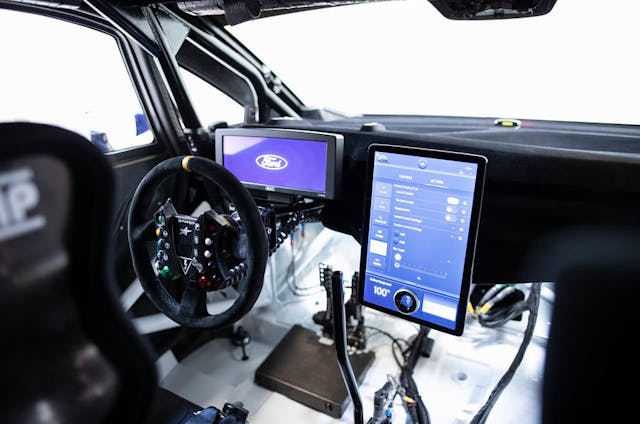
2000PS Ford Electric SuperVan flies up the #FOS Hill.
We think @forduk have taken everyone by surprise with how incredible this thing is. Just look at it. That aero similar to the Ford GT is sublime. #FordSuperVan #EV #gw_ford pic.twitter.com/UfuLDsmRmq
— Goodwood Road&Racing (@GoodwoodRRC) June 23, 2022
For starters, it bears mentioning that while the Ford Transit badge has made it across the Atlantic into North America, the van’s European reputation hasn’t yet made the trip. Americans likely associate the Transit with the plumber that comes to fix your sink. Across the pond, Transits are likewise the tools of tradespeople, a tradition dating back to the mid-1960s. Brits in particular are familiar with an archetype known as “white-van man,” characterized by an overalls-wearing fellow in a white Transit with a ladder strapped to its roof. “White-van man” sits three inches off your rear bumper at eighty-five miles per hour on the freeway. The U.K. may be full of Astons, Jaguars, and Bentleys, but no nameplate is driven with greater ferocity than a working Ford van.
Perhaps as a nod to these working-stiff wheelmen, Ford has periodically dabbled in building its own hot-rod SuperVan. The concept is always simple: Van go fast—really fast. This new electrified version is just the latest iteration, following a trail blazed by these four predecessors.
Supervan 1: Delivery-spec GT40
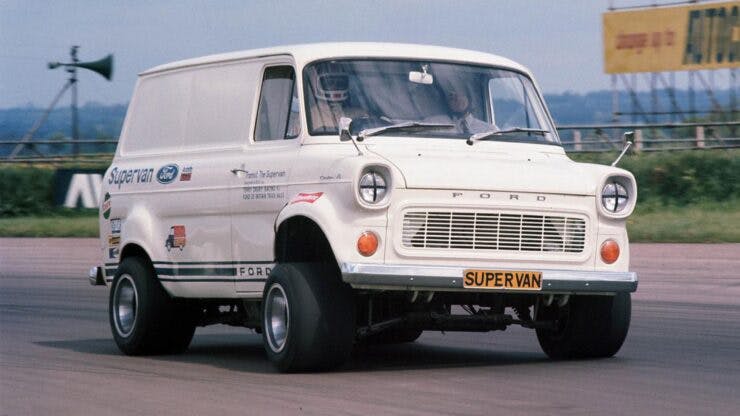
The original Transit debuted in October of 1966. In the same year, Ford broke Ferrari’s winning streak at Le Mans with a Mk II GT40. You can see where this is going.
The idea of a super Transit can be traced back to a couple of freewheeling Ford apprentices at a company trade school in 1971. Students managed to stuff a V-8 into the space where a Transit’s V-6 would normally go, and got it roaring around at a trade show. A Ford publicity exec clocked the admiring crowds and promptly called up an engineer named Terry Drury.
Drury had first-hand experience with the GT40, having personally raced one in the 1967 British Sportscar Championship. Under strict instruction to keep the build looking as much like an ordinary Transit as possible, he lowered the entire bodyshell of a van over the chassis of a GT40.
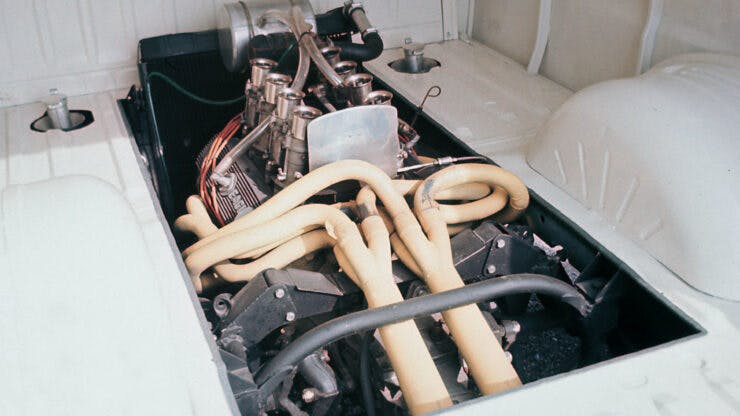
The engine was a 4.0-liter V-8 with Gurney-Westlake heads and was good for an estimated 435 hp. That’s over four hundred horsepower, in 1971, in a massive steel box. Some Jaguar suspension parts went into the build, but Supervan 1 was otherwise not much more than a tuned-up GT40 that could haul around staggering number of toilet plungers.
Add in cartoonishly wide tires on 15-inch wheels, and Supervan 1 resembled a BBC cartoon for children. But this was no toy; owing to the GT40-sourced five-speed ZF gearbox, the first Supervan would do over 100 mph in second gear with a theoretical top speed of 168 mph. It sounded like Le Mans, went like hell, and looked like a window-cleaning service.
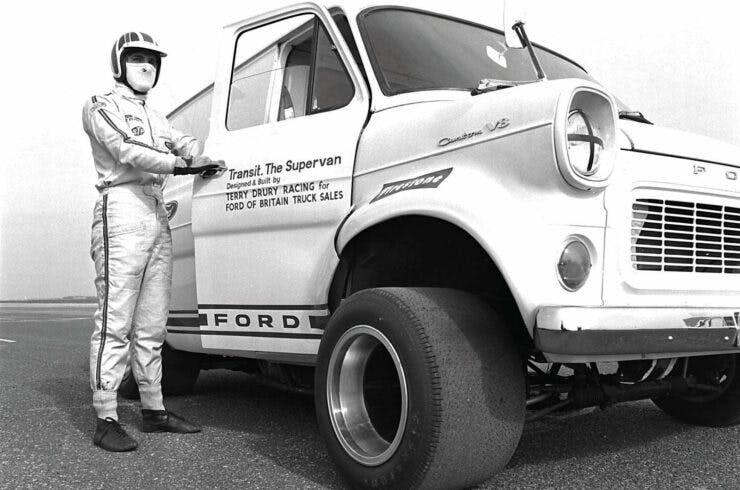
Obviously, everyone loved seeing this thing leaning over in the corners and squatting under acceleration. The V-8 thrust was sufficient to lift one of the front wheels when powering out of a corner. First shown at a race event at Thruxton in the U.K., the Supervan had a long career as a demonstrator. It even made it to the Nürburgring, where it laid down a 9 minute, 13 second demonstration lap time, faster than some of the actual competitors there to race.
Popular as it was, the Supervan’s GT40 components proved too valuable in the end. It was broken for parts some time in the late 1970s.
Supervan 2: Greatness built on failure

A key figure in making sure the original Supervan happened was former BMC competition manager Stuart Turner. Turner was trained as an accountant, but he was a racer through and through. He was present all through the golden era of Mini rallying and won three national-level co-driving championships. Ford made him director of motorsport in 1970 but then sent him to run the public affairs department. By 1983, Turner was back running motorsport for Ford of Europe. Supervan 2 came out one year later.
While the first Supervan owned that quintessential, built-in-a-shed British charm, Supervan 2 took a more modern approach. A design group called Auto Racing Technology consulted on the project; these were the same engineers that helped Ford create the mighty RS200.
One of the two engineers that made up Auto Racing Technology was Tony Southgate. Southgate had previously been called in to consult on the Ford C100, a Group C car made to challenge the Porsche 956 in the same way the GT40 took on Ferrari. He reportedly wasn’t very impressed with the C100, and neither was Turner. The latter canned the C100 program as one of his first actions upon assuming control of Ford motorsports in 1983. So the C100 wouldn’t work at Le Mans; could it work as a van?
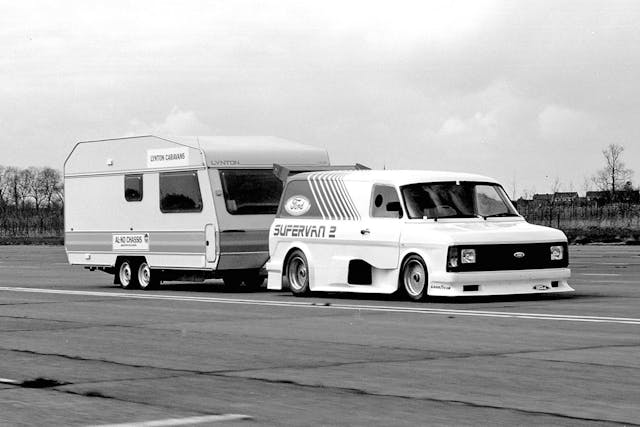
Supervan 2 was 7/10ths the scale of a road-going Transit, its body built of aluminum sheeting and fiberglass. The monocoque was aluminum and carbon fiber, and the mechanical parts were straight from the C100, including a 590-hp Cosworth-built V-8.
Apart from the grille and the overall shape, Supervan 2 was a more radical reimagining of what a Transit could be. However, the top speed wasn’t a guess this time. At Silverstone, it was successfully run up to 176 mph. It was parked in a museum relatively shortly thereafter, but it wasn’t the end of the story …
SuperVan 3: The fastest-ever mail van
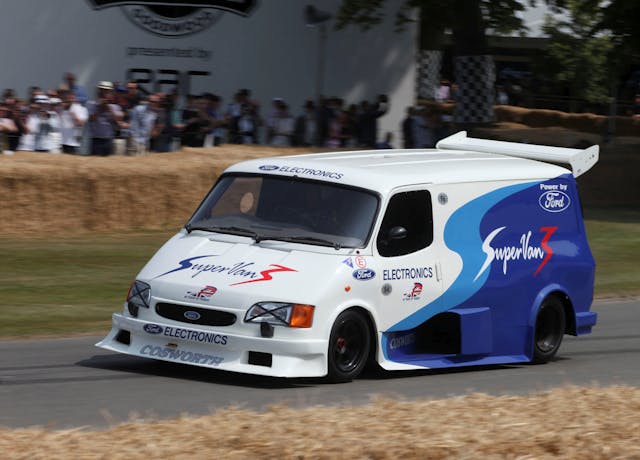
In 1994, Ford launched a facelift for the Transit, which was still only in its second generation. Seeking some positive publicity, the idea to dig the old Supervan 2 out of mothballs, and breathe new life into it, gained favor.
On the outside this amounted to little more than a visual re-skin, with a new nose and doors grafted on to what was basically the same van (the v in SuperVan was now capitalized). The powertrain, on the other hand, was straight-up Formula 1 hardware: a Cosworth-developed Ford HB 3.5 V-8.
Where both previous Supervans had used endurance racing engines, SuperVan 3 got a motor that was the same as found in Ayrton Senna’s McLaren MP4/8. “If you no longer go for a gap that exists, you are no longer a” Ford Transit driver.
In SuperVan 3 spec, this engine was good for 650 hp and 13,000 rpm. The sound of it! (And also the operating expenses!) A Formula 1 heartbeat means F1 running costs, and SuperVan 3 cost a fortune. It was retired in 2001.
But not before a celebratory run at Brands Hatch in its final year. At the time, Ford had just been awarded the contract to supply the Royal Mail’s delivery fleet. As a celebration, SuperVan 3 was kitted out like Postman Pat’s bright red van, and went scorching around the circuit.

SuperVan 3 was re-engined for the Transit’s 40th anniversary, this time with a much tamer 3.0-liter Cosworth V-6. Power was way down, now at about 300 horses. On the other hand, the change did make it possible for more drivers to get behind the wheel of SuperVan 3 and get it out in front of admiring crowds more often.
Bonus SuperVan: TWR XJ220 Mule

Let’s not leave things on that (slightly neutered) V-6 note. Instead, witness the six-cylinder power of one of the fastest road-going Transit ever made: the Walkinshaw Racing XJ220 development mule.
In order to develop the engine for Jaguar’s 213-mph XJ220 supercar, Tom Walkinshaw Racing (TWR) needed a disguise for motorway shakedowns. The ideal fake-mustache was a Ford Transit. A van was common enough not to draw attention, the large storage area provided easy access to the mid-mounted engine, and it had a rear-drive layout. Let’s not forget that a 540-hp Ford van is simply hilarious.
After the XJ220 project ended, the Transit Mule served as the parts delivery truck for the Benetton F1 team, which is even more hilarious. Eventually, it ended up parked and neglected.

Enter Don Law Racing, an XJ220 specialist father-and-son firm in Newcastle (charmingly, their mailing address begins “The Old Cheese Factory”). Not only did the Law family bring the van back to life, they set about improving it. And they did so with a very British sense of humor.
Power was cranked up to 640 hp, and the suspension retuned to get better translate that power to the road. Then came the ladder, firmly attached to the roof, and the logo on the side reading “Goodwood Estate Repairs and Maintenance.” Fast food wrappers and smutty mags were glued to the dashboard. It’s cheeky fun, but the Transit made seriously good time up the hill and hit a top speed of about 170 mph.
Any of these SuperVans would be a crazy dream machine for any U.K. white-van man. Because whether combustion-engined or packed with batteries and electric motors, a rapid Transit is a delightful thing.

